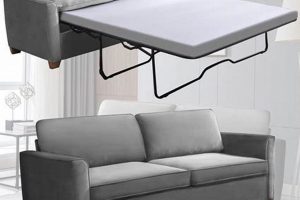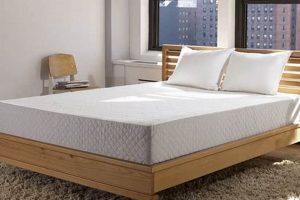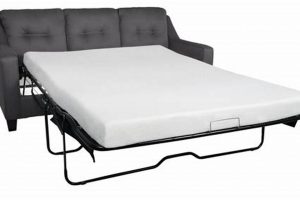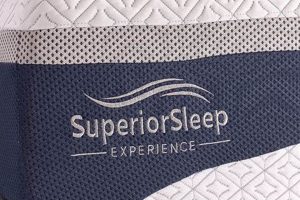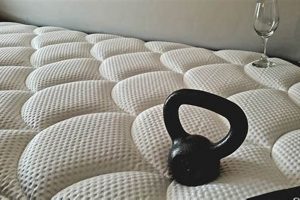This specific type of mattress refers to a product designed with a dual functionality. It aims to provide comfortable support for both seated and supine positions, catering to individuals who spend considerable time sitting in bed, perhaps due to health conditions, lifestyle preferences, or limited living space. An example would be a mattress engineered with reinforced edges to prevent sagging when someone is sitting on the side for extended periods.
The importance of this design lies in its potential to improve comfort and support for individuals with specific needs. It can alleviate pressure points, promote better posture while seated, and contribute to improved sleep quality by offering a consistent level of support across the entire surface. Historically, mattresses were primarily designed for sleeping; however, evolving lifestyles and increasing awareness of ergonomic needs have led to the development of these more versatile options.
Understanding the nuances of materials, construction techniques, and support systems becomes crucial when evaluating the suitability of such a product. The following sections will delve into these key aspects, exploring how different features contribute to the overall performance and longevity of a mattress designed for both sitting and sleeping.
Guidance on Dual-Purpose Mattresses
The following guidelines offer practical advice for selecting and maintaining a mattress engineered for both seated and supine use, ensuring optimal comfort and longevity.
Tip 1: Prioritize Edge Support: Robust edge support is crucial. Look for reinforced edges or coil systems designed to prevent sagging when sitting. This feature extends the usable surface area and maintains structural integrity over time. For example, mattresses with high-density foam encasement offer superior edge support.
Tip 2: Evaluate Zoning: Consider mattresses with zoned support systems. These provide targeted support to different areas of the body, accommodating both the concentrated pressure from sitting and the distributed pressure of sleeping. A zoned mattress may have firmer support in the lumbar region, benefiting both seated posture and spinal alignment during sleep.
Tip 3: Assess Material Density: Higher-density materials generally offer improved durability and resistance to compression. For foam mattresses, pay attention to the density rating; higher densities translate to better support and longevity, especially for frequent sitting. For innerspring mattresses, consider the coil gauge; lower gauges indicate thicker, more durable coils.
Tip 4: Consider Firmness Level: The optimal firmness level depends on individual preferences and body weight. However, a slightly firmer mattress tends to offer better support for sitting without sacrificing sleeping comfort. It is advisable to test various firmness levels in both seated and lying positions before making a decision.
Tip 5: Inquire About Construction: Understanding the internal construction can inform durability expectations. Mattresses with individually wrapped coils, for instance, tend to minimize motion transfer and offer better contouring, benefiting both sitting and sleeping. Research the layering and arrangement of the internal components.
Tip 6: Inspect the Cover Material: The cover material should be breathable and durable. A tightly woven fabric will resist wear and tear from repeated sitting and moving around on the mattress. Consider materials with moisture-wicking properties for enhanced comfort.
Selecting a suitable dual-purpose mattress requires careful consideration of factors such as edge support, zoning, material density, and firmness level. Evaluating these features ensures a product that effectively supports both seated and supine activities.
The subsequent discussion will focus on specific mattress types and technologies relevant to this dual-purpose functionality, providing further insights into the available options.
1. Edge Support
Edge support constitutes a critical factor in the performance and longevity of mattresses designed for both seated and supine use. The connection stems from the distribution of weight. When sitting, an individual’s weight is concentrated on a smaller surface area, typically near the edge of the mattress. Inadequate edge support results in compression and sagging in that region, leading to discomfort, difficulty getting in and out of bed, and a reduction in the usable sleeping surface. A real-life example is a mattress where the edges collapse after a few months of regular sitting, creating an uneven sleeping surface and a feeling of rolling off the bed.
The inclusion of reinforced edge support systems, such as high-density foam encasements or strengthened coil configurations along the perimeter, mitigates these issues. These systems provide greater resistance to compression, maintaining the mattress’s structural integrity and extending its lifespan. Consider a mattress with a reinforced edge; it retains its shape and firmness even after prolonged periods of sitting, providing a stable and comfortable surface for both seated activities and sleep. Furthermore, stronger edges provide safer transfers in and out of bed, important for older adults or individuals with mobility issues.
In summary, robust edge support is integral to the functionality of a mattress designed for sitting and sleeping. Its absence leads to premature wear and diminished comfort, while its presence ensures long-term support, usability, and safety. Understanding this relationship allows for informed purchasing decisions, selecting mattresses engineered to withstand the demands of dual-purpose usage.
2. Zoned Support
Zoned support represents a design strategy implemented in mattresses intended to address the varying support requirements of different body regions. The connection to mattresses designed for both sitting and sleeping lies in the distinct pressure distribution patterns inherent in each activity. When seated, the concentration of weight primarily resides in the pelvic and lumbar regions, demanding firmer support to maintain proper spinal alignment. Conversely, when lying down, the weight disperses across a broader surface area, requiring a more balanced and contouring level of support. Failure to account for these differences can result in discomfort, pain, and compromised sleep quality. For instance, a mattress lacking zoned support might feel comfortable when lying down but cause lower back strain when sitting due to inadequate lumbar support. Therefore, zoned support emerges as a critical component in optimizing the comfort and ergonomic benefits of a dual-purpose mattress.
The practical application of zoned support involves the strategic placement of varying densities of foam or coil configurations within the mattress core. A mattress might feature a firmer center zone to provide enhanced lumbar support for sitting, while the shoulder and hip regions incorporate softer materials for pressure relief during sleep. This differential support aims to accommodate the distinct postural needs of both seated and supine positions. Consider a mattress with a zoned coil system: the central third of the mattress contains heavier gauge coils to resist compression when sitting, while the remaining coils offer more conforming support for sleeping. Such designs demonstrate a tangible effort to optimize the mattress’s performance across diverse use cases. Moreover, some designs may feature enhanced edge support within a zoned system for increased stability when transitioning from lying to seated positions near the edge of the bed.
In conclusion, zoned support serves as a critical feature in mattresses designed for both sitting and sleeping by accommodating the differing support needs of various body regions in both activities. By strategically varying firmness and support levels, such mattresses strive to optimize spinal alignment, pressure relief, and overall comfort, representing a significant advancement over traditional, uniformly supported mattresses. While the effectiveness of zoned support depends on individual body types and preferences, its potential to enhance both sitting and sleeping experiences highlights its value in the context of dual-purpose mattresses. The challenge lies in finding a balance that effectively caters to both use cases without compromising comfort in either position.
3. Material Density
Material density is a crucial factor determining the long-term performance and suitability of mattresses designed for both seated and supine use. It directly influences the mattress’s ability to withstand repeated compression, maintain its structural integrity, and provide consistent support over time.
- Foam Mattress Density and Support
In foam mattresses, density signifies the amount of material packed into a given volume. Higher density foams exhibit greater resistance to compression and deformation, crucial for supporting concentrated weight when sitting. For instance, a high-density memory foam mattress will retain its shape and support, even after prolonged periods of sitting, preventing sagging and ensuring consistent comfort. Conversely, a low-density foam will quickly compress and lose its supportive qualities, leading to discomfort and premature wear.
- Innerspring Mattress Coil Gauge and Durability
While innerspring mattresses rely on coil systems for support, the density of the surrounding materials, such as comfort layers, still plays a role. Furthermore, the coil gauge (thickness) functions similarly to density in foams. Lower gauge numbers indicate thicker coils, which offer increased resistance to compression and enhanced durability. A mattress with a low coil gauge can better withstand the stresses of both sitting and sleeping, maintaining its structural integrity and support over time.
- Impact on Edge Support
The material density is particularly critical for edge support systems. Mattresses with high-density foam encasements along the perimeter provide superior resistance to sagging when sitting on the edge of the bed. This feature not only expands the usable sleeping surface but also contributes to easier and safer transitions in and out of bed. For example, a mattress with a low-density foam edge will quickly collapse under pressure, compromising both comfort and stability.
- Long-Term Performance and Longevity
The density of materials directly affects the mattress’s overall lifespan. Higher density foams and thicker coils are more resistant to wear and tear, allowing the mattress to maintain its supportive properties for a longer period. This translates to a better return on investment, as the mattress is less likely to require replacement due to sagging, compression, or loss of support. For instance, a high-density latex mattress can retain its shape and support for many years, even with frequent use for both sitting and sleeping.
In summary, material density is a fundamental consideration when evaluating mattresses designed for dual purposes. Higher density materials provide greater resistance to compression, enhanced durability, and improved long-term performance, ensuring that the mattress can effectively support both seated and supine activities without compromising comfort or structural integrity.
4. Firmness Level
Firmness level, denoting the perceived softness or hardness of a mattress surface, assumes critical importance when evaluating mattresses designed for both seated and supine use. The optimal firmness is not a universal constant, but rather a variable influenced by individual preferences, body weight, and habitual posture. A mismatch between firmness and individual needs can compromise comfort, support, and overall sleep quality, especially when the mattress serves dual purposes.
- Spinal Alignment and Postural Support
The primary role of mattress firmness is to maintain proper spinal alignment. When seated, the spine adopts a different curvature than when lying down. A mattress that is too soft may allow excessive sinking, leading to spinal misalignment and lower back pain, particularly during prolonged periods of sitting. Conversely, a mattress that is too firm may create pressure points, preventing proper contouring and causing discomfort. The ideal firmness level provides sufficient support to maintain a neutral spine in both seated and supine positions. For example, a medium-firm mattress might offer balanced support for individuals who spend time sitting in bed reading, while also conforming adequately to their body contours during sleep.
- Weight Distribution and Pressure Relief
Firmness influences the distribution of weight across the mattress surface. When sitting, the weight is concentrated in a smaller area, typically the buttocks and thighs. A firmer surface can better distribute this concentrated weight, preventing pressure points and minimizing discomfort. However, excessive firmness can lead to pressure buildup in these areas. When lying down, the weight is distributed more evenly. A softer surface may provide better pressure relief for individuals with joint pain or pressure sensitivity. The optimal firmness level balances support and pressure relief for both seated and supine activities. An individual who experiences hip pain might find that a slightly softer mattress provides better pressure relief while sleeping, while still offering adequate support for sitting.
- Edge Support and Seated Stability
The firmness of the mattress, particularly at the edges, directly impacts stability and support when sitting on the side of the bed. A firmer edge provides greater resistance to compression, preventing sagging and making it easier to get in and out of bed. Mattresses with weak edge support may compress significantly when sitting, creating an unstable and uncomfortable surface. Firmness contributes to the overall structural integrity of the edge, enhancing its ability to support weight. A mattress with reinforced edges and a firmer overall construction provides a more stable and secure seating surface.
- Sleeping Position Considerations
While the primary focus is on dual functionality, the individual’s preferred sleeping position remains a relevant consideration. Side sleepers generally benefit from softer mattresses that conform to the curves of their body, while back and stomach sleepers often prefer firmer mattresses that provide better spinal support. Balancing these preferences with the need for adequate support while sitting requires careful consideration. A compromise might involve a medium-firm mattress with targeted support zones, providing adequate support for back sleeping and sitting while still offering some contouring for side sleeping.
The selection of an appropriate firmness level for a mattress designed for both sitting and sleeping necessitates a careful evaluation of individual needs and preferences. It’s crucial to consider factors such as spinal alignment, weight distribution, edge support, and sleeping position to ensure optimal comfort and support in both seated and supine positions. The ability to test the mattress in both positions, if possible, allows for a more informed decision.
5. Construction Integrity
Construction integrity, defined as the soundness and durability of a mattress’s internal structure, is a critical determinant of the suitability and longevity of a mattress designed for both sitting and sleeping. The relationship stems from the dual demands placed upon the product. A mattress intended solely for sleeping experiences relatively uniform weight distribution across its surface. Conversely, a mattress also used for sitting endures concentrated pressure points, especially along the edges and in specific zones. Inadequate construction integrity leads to premature sagging, uneven support, and a diminished lifespan.
A mattress with poor construction integrity might exhibit coil breakdown, foam compression, or seam failures within a short period of usage. This is particularly evident in mattresses with low-quality materials or inadequate assembly techniques. For instance, a mattress featuring glued-together layers may delaminate under stress, resulting in discomfort and compromised support. In contrast, a mattress constructed with high-density foams, reinforced coil systems, and meticulous stitching techniques demonstrates superior resistance to deformation and maintains its supportive qualities over extended periods. Consider a scenario where an individual habitually sits on the edge of the bed. A mattress with robust edge support, achieved through high-density foam encasement and reinforced coils, will retain its shape and provide consistent support. However, a mattress lacking these features will quickly develop a noticeable sag, compromising its structural integrity and impacting sleep quality.
Understanding the connection between construction integrity and performance allows informed purchasing decisions. It is crucial to examine the materials used, the assembly methods employed, and the presence of reinforced support systems. Selecting a mattress with robust construction integrity ensures that it can withstand the demands of dual-purpose usage, providing consistent comfort and support for both sitting and sleeping. While initial cost may be higher for mattresses with superior construction, the extended lifespan and improved performance represent a worthwhile investment. The challenges in assessing construction integrity lie in the difficulty in examining the internal components without disassembling the mattress. Therefore, relying on reputable brands, thorough product specifications, and customer reviews becomes paramount.
6. Cover Durability
Cover durability directly influences the longevity and hygiene of mattresses designed for both sitting and sleeping. This stems from the increased wear and tear associated with dual-purpose usage. While a mattress solely used for sleep primarily experiences friction from bedding and occasional movement, a mattress also employed for sitting undergoes concentrated pressure, abrasion, and potential staining from various activities.
- Resistance to Abrasion and Pilling
A durable cover resists abrasion and pilling caused by repeated sitting and shifting. Materials like tightly woven fabrics or those incorporating reinforced fibers maintain their structural integrity, preventing the formation of unsightly pills and thinning of the fabric. A cover that easily pills deteriorates quickly, compromising the mattress’s aesthetic appeal and potentially leading to further damage. Conversely, a cover with high abrasion resistance sustains its appearance and protective function, extending the mattress’s usable lifespan. An example is a mattress cover made of polyester blend with a high thread count, which will withstand frequent use better than a loosely woven cotton cover.
- Stain Resistance and Cleanability
Covers with inherent stain resistance or those treated with stain-repellent finishes prevent liquids and spills from penetrating the mattress core. This is particularly important in mattresses used for sitting, where accidental spills from food or beverages are more likely. Easy cleanability allows for quick removal of stains, maintaining hygiene and preventing the growth of mold and bacteria. A mattress cover with a waterproof or stain-resistant coating protects the inner layers from damage, extending its lifespan. For instance, a mattress cover treated with a hydrophobic coating will repel liquids, allowing them to be easily wiped away.
- Breathability and Moisture Management
A breathable cover facilitates air circulation, preventing the buildup of moisture and heat within the mattress. This is crucial for maintaining comfort and preventing the growth of mold and mildew. Materials like natural fibers (e.g., cotton, bamboo) or synthetic fabrics with open-weave structures promote airflow, regulating temperature and reducing humidity. A mattress cover that traps moisture can create an environment conducive to bacterial growth, affecting both hygiene and comfort. A mattress cover made of bamboo fibers offers excellent breathability and moisture-wicking properties, promoting a cooler and more comfortable sleep surface.
- Seam Strength and Construction
The seams connecting the cover panels are vulnerable points. Reinforced seams, employing durable stitching techniques and high-quality threads, prevent tearing and separation, particularly under the stress of concentrated weight. Strong seams ensure the cover remains intact, protecting the underlying mattress layers. A mattress cover with poorly constructed seams will quickly unravel, compromising its structural integrity and allowing contaminants to enter the mattress core. A cover with double-stitched and reinforced seams provides enhanced durability and resistance to wear and tear.
These facets highlight the critical role of cover durability in mattresses intended for both sitting and sleeping. Choosing a mattress with a durable, stain-resistant, breathable, and well-constructed cover ensures long-term comfort, hygiene, and protection of the underlying mattress components. Neglecting cover durability can lead to premature wear, hygiene issues, and a significantly shortened lifespan for the mattress.
Frequently Asked Questions About Mattresses Designed for Sitting and Sleeping
The following addresses common inquiries regarding mattresses engineered for both seated and supine activities. The information presented aims to provide clarity and inform decision-making.
Question 1: What distinguishes a mattress designed for sitting and sleeping from a conventional mattress?
A mattress intended for dual purposes incorporates features specifically addressing the concentrated pressure points associated with seated positions. Conventional mattresses are primarily optimized for evenly distributed weight during sleep. The former typically exhibits enhanced edge support, zoned support systems, and durable materials to withstand frequent sitting.
Question 2: Is a firmer mattress always preferable for dual-purpose usage?
While a firmer mattress can provide better support when sitting, the ideal firmness level depends on individual preferences and body weight. A mattress that is too firm may create pressure points and discomfort during sleep. The optimal choice balances support for seated activities with comfort for supine positions.
Question 3: How does edge support contribute to the functionality of these mattresses?
Edge support is critical in preventing sagging and providing a stable surface when sitting on the edge of the bed. It also expands the usable sleeping area and facilitates easier transfers in and out of bed. Robust edge support enhances the overall lifespan and usability of the mattress.
Question 4: What materials are most suitable for mattresses designed for both sitting and sleeping?
High-density foams, reinforced coil systems, and durable cover fabrics are generally recommended. These materials offer improved resistance to compression, abrasion, and deformation, ensuring long-term support and comfort.
Question 5: How should one maintain a mattress intended for dual-purpose use to prolong its lifespan?
Regular rotation, vacuuming, and the use of a mattress protector can help maintain its integrity. Addressing spills promptly and avoiding excessive weight concentration in specific areas can also extend its lifespan.
Question 6: Can these mattresses accommodate different sleeping positions?
Yes, but it’s crucial to select a mattress with appropriate firmness and support characteristics to suit individual sleeping positions. A medium-firm mattress with targeted support zones can often accommodate various sleeping styles while still providing adequate support for sitting.
In summary, selecting a mattress engineered for both sitting and sleeping requires careful consideration of several factors, including firmness level, edge support, material density, and individual preferences. Understanding these elements facilitates informed purchasing decisions and ensures long-term satisfaction.
The following section will explore specific product recommendations, offering insights into available options and their respective features.
Conclusion
The preceding discussion has explored the defining characteristics and critical considerations surrounding the “sit and sleep mattress” category. Emphasis has been placed on the significance of edge support, zoned support systems, material density, firmness level, construction integrity, and cover durability. Each of these aspects contributes directly to the product’s ability to effectively serve its dual purpose, providing comfortable support for both seated and supine activities.
Ultimately, the selection of a suitable “sit and sleep mattress” requires a comprehensive understanding of individual needs and a careful evaluation of available options. While the features discussed provide a valuable framework for assessment, individual preferences and body types remain paramount. Continued advancements in materials and construction techniques suggest a future where dual-purpose mattresses offer even greater comfort, support, and longevity. Further research and informed consumer choices will drive innovation and refine this specialized segment of the bedding market.


